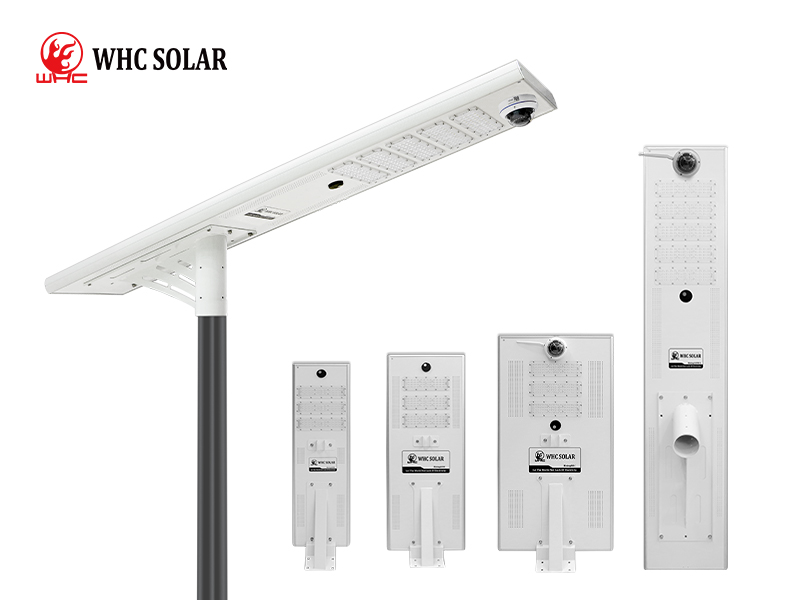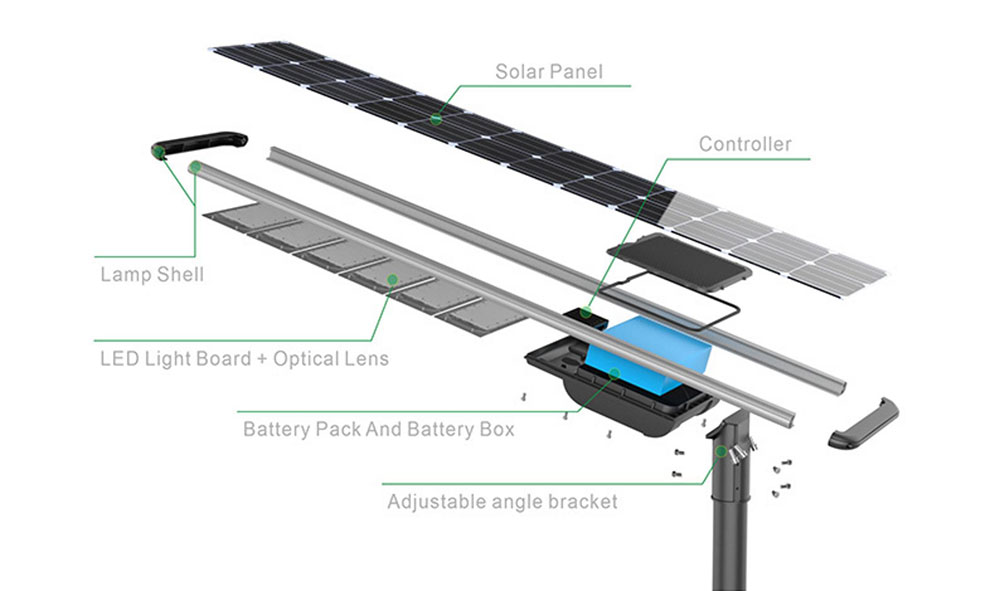As the world is progressing towards development, solar street lights come out as beacons of innovation. Imagine streets bathed in a gentle, eco-friendly glow, powered not by conventional electricity grids but by the inexhaustible energy of the sun. As our cities evolve, so must our approach to urban lighting, and solar street lights are at the forefront of this transformative change.
With a seamless blend of advanced technology and renewable energy, solar street lights are revolutionizing how we illuminate our public spaces. This article takes a closer look at the brilliance behind solar street lights, exploring their benefits, functionality, and positive impact on our communities and the planet.

What are solar street lights?
Solar street lights are like enchanted vessels for our streets that run on sunlight. Instead of using regular electricity, these lights have special panels on top that soak up sunshine during the day. It’s like the panels are giving the lights a sun-powered battery.
This energy gets saved up, so when the sun takes a break at night, the lights can still shine bright. Picture it like the lights are using the sun’s leftover power from the day to light up our streets at night.
They’re not only cool because they use the sun, but they’re also good for the planet since they don’t need electricity from big power stations. So, solar street lights are kind of like nature-friendly lights!
Main components of solar street lights:
Solar street lights consist of the following parts:
- Led light:
The LED light is the star player in solar street lights, responsible for providing bright and efficient illumination. LEDs (Light Emitting Diodes) are chosen for their energy efficiency and longevity. These lights come in various wattages and designs to meet specific lighting requirements for streets, pathways, or other outdoor areas. - Solar panel:
The solar panel is like the power source for solar street lights. It captures sunlight and transforms it into electricity, a process known as photovoltaic conversion. Typically mounted at the top of the light pole or in a separate fixture, the solar panel plays a crucial role in harnessing solar energy to power the lights. - Battery:
Solar street lights use batteries to store the energy collected from the solar panels during the day. There are two main types of batteries used in solar street lights: lithium batteries and lead acid batteries. Lithium batteries are often chosen for all-in-one solar street lights due to their compact size, light weight, and durability. Lead acid batteries are suitable for split or semi-split solar street lights, providing reliable energy storage.
● Lithium battery: Lithium batteries are well-suited for all-in-one solar street lights, offering a high energy density and longer lifespan. Their compact design allows for easy integration into the light fixture.
● Lead acid battery:Lead acid batteries, known for their reliability and cost-effectiveness, are commonly used in split or semi-split solar street lights. These batteries store the solar-generated energy for use during the night.
4.Controller:
The controller serves as the brain of the solar street light system. It manages the energy flow, ensuring that the battery is charged efficiently and controlling when the LED lights are turned on and off. The controller also protects the battery from overcharging or deep discharging, contributing to the overall efficiency and longevity of the solar street light system. It plays a crucial role in optimizing energy usage and ensuring reliable operation.
What varieties of solar-powered street lighting solutions are available?
Solar street lights are of three types. Read on to know what these are:
1.Split solar street light
Split solar street lights have two main parts: the solar panel and the light itself. The solar panel is usually installed separately, often on top of a pole or another location where it can catch the most sunlight. It’s connected to the light through wires. This design allows for flexibility in placing the solar panel in the best position for maximum sunlight exposure. These lights are a good choice when you want to illuminate specific areas and need the solar panel to be positioned separately for optimal energy absorption.
2.All-in-one solar street light
As the name suggests, all-in-one solar street lights integrate all components into one compact unit. The solar panel, battery, LED lights, and other electronics are all housed in a single fixture. This design makes installation simpler and more straightforward since there’s only one unit to set up.
All-in-one solar street lights are often chosen for their ease of installation and maintenance. They are convenient for locations where a streamlined and hassle-free lighting solution is preferred.
3.All-in-two solar street light
All-in-two solar street lights are a hybrid between the split and all-in-one designs. These lights separate the solar panel and the LED light but keep them closely connected. The solar panel is usually connected to the light through a cable, providing some flexibility in positioning while maintaining a more compact setup than split solar lights.
This design offers a balance between the installation flexibility of split lights and the integrated simplicity of all-in-one lights.
Each type of solar street light has its advantages, and the choice depends on factors such as installation preferences, specific lighting needs, and environmental conditions in the area where they will be used.

Advantages of solar street lights:
Solar street lights offer a multitude of benefits that make them an increasingly popular choice for outdoor lighting solutions. One significant advantage lies in their environmental friendliness. By harnessing energy from the sun, solar street lights operate without relying on conventional electricity, reducing the carbon footprint associated with traditional lighting. This eco-friendly approach contributes to sustainable urban development and helps combat climate change.
Solar street lights are cost-effective in the long run. While the initial installation may involve a higher upfront cost, the absence of ongoing electricity bills compensates for this over time. Solar street lights are essentially self-sufficient, drawing energy from the sun and requiring minimal maintenance. This autonomy makes them an economical option for both municipalities and businesses, offering significant savings in operational expenses.
The versatility of solar street lights is another advantage worth noting. They can be installed in remote or off-grid areas where connecting to the main power grid would be impractical or expensive. Additionally, the modular design of some solar street lights allows for easy scalability, enabling the adjustment of lighting solutions based on specific needs and available sunlight.
Moreover, solar street lights enhance safety and security in urban and rural environments. Their bright LED illumination ensures well-lit streets, reducing the risk of accidents and deterring potential criminal activities. In areas prone to power outages, solar street lights continue to function independently, providing a reliable source of light even during emergencies.
In short, the advantages of solar street lights extend beyond their energy efficiency to encompass economic savings, adaptability to various environments, and the promotion of safety and sustainability in our communities.
Solar street light installation process:
Solar street lights can be installed by considering the following guidelines in sequence:
- Evaluating the location where solar lights will be installed
- Prepare the foundation for the light pole
- After preparing the foundation, securely install the light pole.
- Attach the solar panel on the light pole’s top. Note that always place the solar panel in such a place where they can trap optimal sunlight.
- In the base of the light pole, install the controller and battery in a weatherproof enclosure nearby.
- Connect the LED lights with the apparatus
- Last but not least, after installation, run testing to ensure the proper functioning of the apparatus. Make sure that the lighting is working perfectly, the battery is optimally charging and providing the appropriate voltage, etc.
Conduct a final inspection to ensure it meets safety standards and local regulations.

Maintenance tips for long-lasting solar street lights:
Maintaining solar street lights is crucial for ensuring their long-lasting performance and sustainability. Regular upkeep not only maximizes the efficiency of the system but also extends its lifespan. One key aspect of maintenance is keeping the solar panels clean. Dust, dirt, or debris can accumulate on the panels, reducing their ability to capture sunlight. Regularly cleaning the solar panels with a soft cloth or sponge and mild detergent helps optimize energy
absorption. Additionally, inspecting the wiring and connections for any signs of wear or damage is essential. Ensure that all connections are tight and well-protected from environmental elements to prevent potential issues.
Regular checks on the condition of the battery are also vital for the longevity of solar street lights. For systems with lithium batteries, monitoring their charging and discharging cycles can help identify any irregularities. In the case of lead acid batteries, checking the electrolyte levels and ensuring proper ventilation is crucial. It’s advisable to replace batteries when their performance declines to maintain the system’s efficiency.
Moreover, verifying the functionality of the controller is a key part of solar street light maintenance. The controller manages the charging and discharging cycles, so any issues with its operation could affect the overall system performance. Regular inspections and testing ensure that the controller is functioning correctly, and any necessary adjustments can be made promptly.
Providing proper training to maintenance personnel or end-users on these maintenance tasks ensures that the system continues to operate efficiently, providing sustainable and reliable lighting for streets and outdoor spaces.

